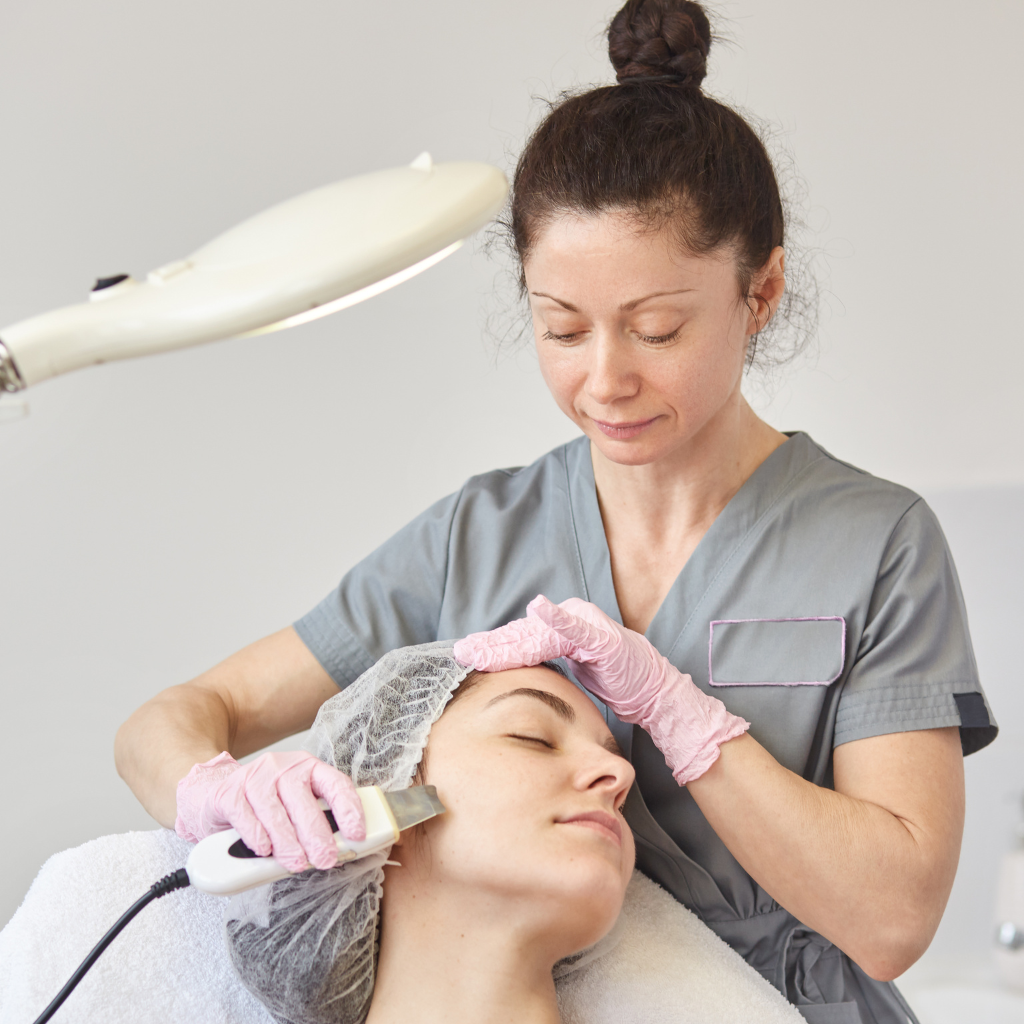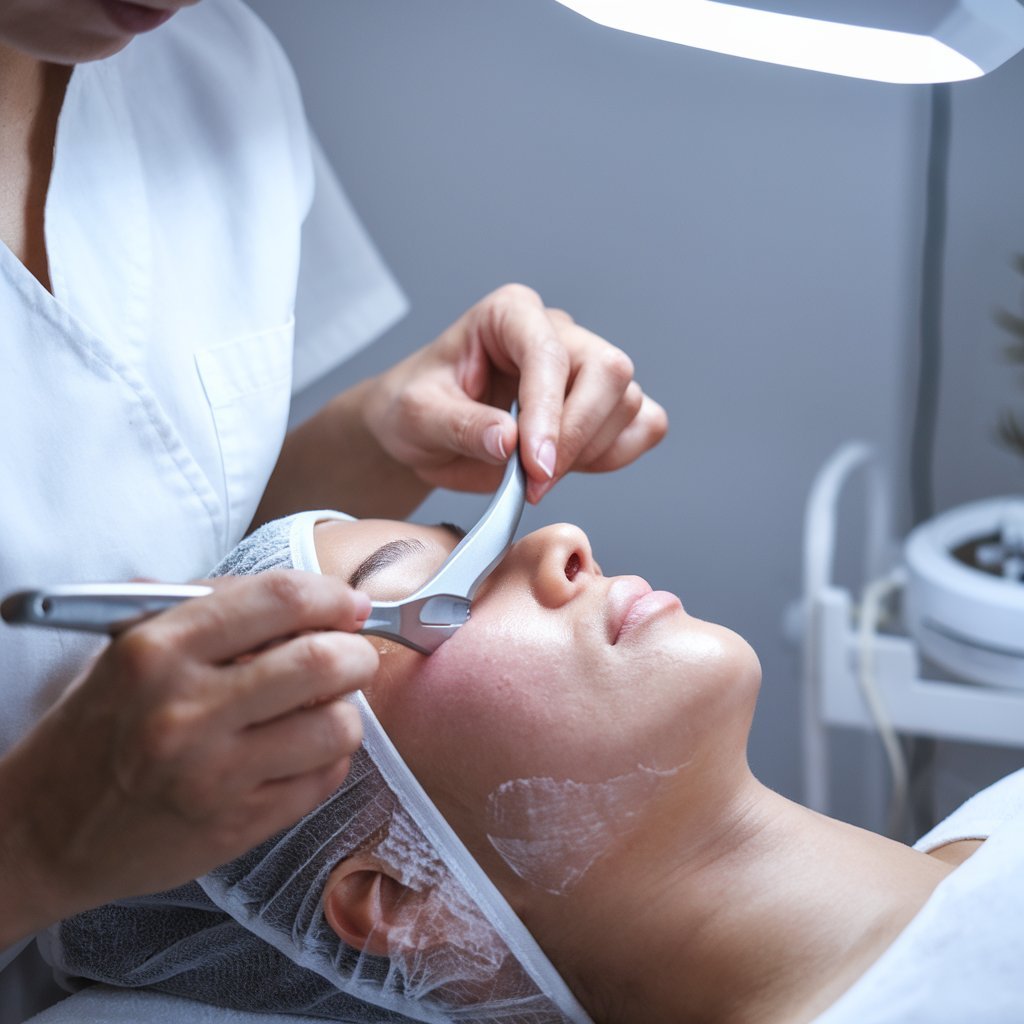How Dermaplaning Facial Treatments Work to Transform Your Skin
- Home
- Skin rejuvenation
- what is dermaplaning

Dermaplaning facial treatments involve a meticulous process where a sterile surgical scalpel exfoliates the skin, carefully scraping away dead cells and fine hairs. This treatment enhances skin texture and clarity by promoting deeper penetration of skincare products and stimulating new skin cell growth. Clearing these superficial layers also helps to minimize the appearance of fine lines and acne scars. For continued benefits and improved skin health, periodic sessions are recommended.
What is dermaplaning, and how does it work?
Dermaplaning is a cosmetic procedure involving the controlled scraping of the skin using a sterile surgical scalpel to remove dead skin cells and peach fuzz, promoting a smoother skin surface.
During the session, trained professionals carefully handle the tool to guarantee precision and safety, targeting the outermost layers of the skin without invasive cutting.
Classified as a non-invasive treatment, dermaplaning provides exfoliation and hair removal without requiring incisions or recovery time, making it a popular choice for enhancing skin texture and tone.
How does a dermaplaning procedure remove dead skin cells?
A significant number of individuals seek out dermaplaning to rejuvenate their skin’s appearance.
This exfoliating treatment involves a carefully executed procedure where a sharp blade removes dead skin cells from the skin’s surface. Specifically, dermaplaning treatments target the top layer of dead skin, effectively scraping it away.
This action removes dead skin cells and promotes a smoother skin texture. As the sharp blade glides over the skin, it meticulously lifts and separates the dull, dead outer layer of skin cells, which can contribute to a lackluster complexion and clogged pores.
The result of a dermaplaning facial is a more skin smoother, refreshed, brighter skin surface that appears smoother and more youthful. Many individuals find that using a natural primer post-treatment helps enhance the evenness of their complexion.
What tools are used during a dermaplaning session
Specialized tools are vital for effectively executing a dermaplaning session, primarily involving a sterile surgical scalpel.
This scalpel is meticulously designed to safely and efficiently remove the outermost layer of skin and vellus hair, commonly called “peach fuzz.”
The precision of professional dermaplaning tools guarantees a smooth glide across the skin surface, facilitating the removal of dead skin cells without irritation.
For those opting for at-home dermaplaning, specific tools tailored for personal use are available, though they generally offer less precision than professional-grade equipment.
Both professional and at-home tools are critical in promoting enhanced skin absorption of skincare products post-procedure, ultimately optimizing the rejuvenating effects of the dermaplaning session. Some clients prefer using numbing cream before professional sessions to minimize discomfort during the procedure.

Is dermaplaning a non-invasive treatment
Dermaplaning is a non-invasive cosmetic treatment designed to enhance skin care by removing fine facial hairs and exfoliating the outermost layers of dead skin cells and peach fuzz. This method employs a sterile, surgical scalpel to gently scrape the skin’s surface, promoting the exfoliation process without chemical peels or invasive techniques. The treatment reveals new skin cells and contributes to a smoother skin texture and a natural glow.
|
Aspect |
Description |
Benefit |
|
Method |
Physical exfoliation with a scalpel |
Non-invasive, safe |
|
Target |
Dead skin cells, fine facial hairs |
Enhances texture, appearance |
|
Outcome |
Removal of superficial debris |
Promotes new cell growth |
|
Frequency |
Typically once a month |
Sustains skin health |
|
Recovery |
No downtime required |
Immediate return to daily activities |
How often should you dermaplaning?
The frequency of dermaplaning treatments should be carefully considered, as the procedure involves the physical exfoliation of the stratum corneum, which can affect the skin’s barrier function.
Typically, it is recommended that individuals undergo dermaplaning every three to four weeks to align with the natural cycle of skin cell regeneration and avoid excessive irritation. This helps rid the skin of buildup while preventing excessive exfoliation.
However, those with sensitive skin types may require extended intervals between sessions or special precautions to minimize potential adverse effects such as redness and sensitivity.
Additionally, applying at least SPF 30 after dermaplaning is essential to protect the freshly exfoliated skin from sun damage and environmental exposure.
How frequently should dermaplaning be done?
Typically, dermaplaning can be safely performed every three to four weeks. This regularity supports the skin’s natural regeneration cycle, which spans about 28 days.
Regular treatments help maintain the benefits of dermaplaning, This process yields a youthful glow and facilitates the better absorption of skin care products by eliminating barriers to penetration.
Additionally, dermaplaning removes surface irregularities, contributing to an even skin tone and reducing the appearance of fine lines. Consequently, with consistent sessions, clients often report enhanced effectiveness of their skincare regimen and prolonged enhancement in skin texture and appearance.
Therefore, adhering to this frequency can optimize both short-term radiance and long-term skin health.
Can sensitive skin types handle regular dermaplaning
Sensitive skin types can be more prone to dermaplaning side effects such as irritation and redness.
Regular dermaplaning involves removing the top layer of dead skin cells and peach fuzz, which can expose sensitive skin to environmental stressors. This practice might disrupt the skin barrier, especially in those using acne medication or with underlying skin issues.
However, those with sensitive skin may still benefit from its effects with careful management and by incorporating dermaplaning into their skincare regimen less frequently.
It is advisable to perform a patch test and consult a dermatologist before including regular dermaplaning at home or as part of a professional treatment plan. Those with active breakouts should avoid the procedure, as it may worsen acne by spreading bacteria.
What are the benefits of dermaplaning?
Dermaplaning is recognized for its efficacy in enhancing skin texture and alleviating dullness by exfoliating the stratum corneum, thereby promoting a smoother and more radiant complexion.
Additionally, this treatment can contribute to the reduction of fine lines and wrinkles by removing dead skin cells and accelerating the turnover of skin cells, which encourages the production of new, healthier skin.
Moreover, dermaplaning is beneficial in managing acne scars, as it helps to even out skin surface irregularities and can make scars less noticeable over time, much like a vampire facial treatment that also aims to rejuvenate skin and improve texture.

How does derma planning improve dull skin and texture?
While dermaplaning primarily targets removing dead skin cells and fine facial hair, its benefits extend greatly to improving dull skin and texture. This cosmetic procedure enhances the skin’s overall appearance by meticulously scraping away the uppermost layer of dermal debris.
Here are key ways dermaplaning rejuvenates dull and textured skin:
- Exfoliation: Dermaplaning facilitates deep exfoliation, removing dead skin and peach fuzz that contribute to skin dullness and uneven texture.
- Enhanced Product Absorption: Post-treatment, skincare products penetrate more effectively, maximizing their benefits due to the elimination of surface barriers.
- Stimulated Collagen Production: The mechanical action of dermaplaning can boost collagen synthesis, improving skin elasticity and firmness.
- Brightened Complexion: It helps even out skin tone, reducing the appearance of dullness and enhancing natural radiance.
Does dermaplaning help with fine lines and wrinkles?
Although primarily recognized for its exfoliating capabilities, dermaplaning also offers benefits for reducing fine lines and wrinkles.
This treatment, performed by a licensed professional, involves carefully removing the top layer of skin using a specialized scalpel. By stripping away dead skin cells and removing fine facial hairs, dermaplaning can significantly smooth the skin’s surface.
This process helps to minimize the appearance of fine lines and wrinkles, making them less noticeable and giving the skin a more youthful look. The removal of the outermost layers encourages the regeneration of new skin cells, which enhances skin elasticity and firmness.
Regular sessions can lead to sustained improvement in uneven skin tone and texture and reduced signs of aging.

Does dermaplaning make hair grow back thicker?
A common concern regarding dermaplaning is whether it influences hair regrowth, specifically regarding thickness and texture.
Scientifically, dermaplaning affects only the surface layer of the skin and does not alter the structure of the hair follicle; therefore, the hair will grow back at the same thickness and rate as before the treatment.
This dispels the myth that dermaplaning can cause facial hair to grow back thicker or coarser, a misconception often rooted in anecdotal evidence rather than clinical research.
What happens to facial hair after dermaplaning
Many individuals express concern that dermaplaning, a cosmetic procedure involving manual exfoliation and removal of dead skin and vellus hair, could cause hair to grow back thicker or coarser.
Here is what happens to facial laser hair removal after dermaplaning:
- Hair Removal: Dermaplaning cuts hair at the skin level, effectively removing the fine hairs and peach fuzz from the face.
- Regrowth Process: Contrary to popular belief, the hair will grow back to its original thickness and texture, as dermaplaning does not alter the hair follicle.
- Texture and Appearance: Post-treatment, the delicate hairs retain soft and fine characteristics; dermaplaning only affects the hair above the skin.
- Long-Term Effects: Regular dermaplaning reveals smoother skin but does not cause hair to grow back thicker or coarser over time.
Addressing the myth: Does dermaplaning cause hair to grow back differently?
A common misconception is that dermaplaning causes hair to grow back thicker or darker. However, dermaplaning works by exfoliating the epidermis and removing fine vellus hair, also known as peach fuzz. The process does not directly influence the skin growth of the follicles; as a result, it does not alter the texture or color of the hair. Individuals who try dermaplaning may notice that hair returns with the same characteristics as before treatment.
Aspect | Detail |
Hair Texture After | No change in thickness |
Hair Color After | No change in darkness |
Impact on Hair Follicles | Does not affect |
Recommendation | Suitable for removing unwanted hair without altering hair growth characteristics |
When should you avoid dermaplaning?
Dermaplaning carries specific considerations for certain skin types and conditions that necessitate caution or outright avoidance.
Particularly, individuals with active acne should refrain from dermaplaning because the procedure can lead to further irritation or spread of acne bacteria.
Additionally, those with sensitive skin or certain skin conditions, such as rosacea or eczema, may experience exacerbated symptoms or adverse effects following the treatment.
Are there any dermaplaning side effects
While dermaplaning is generally considered safe for many individuals seeking smoother, rejuvenated skin, it is not without potential side effects. Individuals should consider their health history and specific skin conditions to determine if dermaplaning is appropriate.
Here are key reasons to avoid dermaplaning:
- Sensitive Skin: Dermaplaning can lead to irritation and redness in those with highly sensitive skin.
- Infectious Skin Conditions: Avoid dermaplaning in the presence of any skin infection to prevent spreading.
- Recent Chemical Peels or Laser Treatments: Skin should fully heal to prevent exacerbated side effects.
- Skin Cancer: Active or recent skin cancer patients should consult their dermatologist, as the procedural trauma could affect the skin’s integrity.
Considering these factors helps guarantee the safety and effectiveness of dermaplaning treatments.
Why it’s best to stop dermaplaning if you have active acne
Dermaplaning is a minimally invasive treatment involving carefully scraping the epidermal layer and vellus hair. It is best to avoid dermaplaning on inflamed or infected skin because the procedure can exacerbate acne by spreading bacteria across the skin, potentially leading to additional outbreaks.
Moreover, dermaplaning is generally not designed to manage or mitigate acne but focuses on surface-level improvements. Because dermaplaning doesn’t address underlying skin issues such as bacteria or sebum production, those with active acne may want to avoid dermaplaning until their skin condition improves.
Who should avoid dermaplaning based on skin type?
Individuals with certain skin types should exercise caution before opting for dermaplaning.
- Acne-Prone Skin: Regular dermaplaning sessions may exacerbate the condition by spreading bacteria to those with active acne or frequent breakouts.
- Mature Skin: While some believe dermaplaning is right for removing dead cells, mature skin might be too delicate for such treatments, risking micro-tears and irritation.
- Skin with Thick Hair: Dermaplaning differs from shaving; dense facial hair can hinder achieving desired results and may lead to uneven texture post-treatment.
Conclusion
To summarize, dermaplaning is a clinically endorsed skin rejuvenation procedure that effectively removes dead skin cells and vellus hair, enhancing skin texture and clarity. Contrary to common myths, it does not thicken hair regrowth. However, it is unsuitable for individuals with certain skin conditions. Unlike traditional shaving, dermaplaning employs a precise surgical scalpel and professional technique to remove hair and achieve more refined results. Regular sessions are recommended to maintain peak skin health and appearance.

Dr. Sheena Majella is a certified dermatologist and the leading skin specialist at Tune Aesthetics. With a deep passion for skin health and beauty, she combines medical expertise with advanced aesthetic treatments to help clients look and feel their best.





